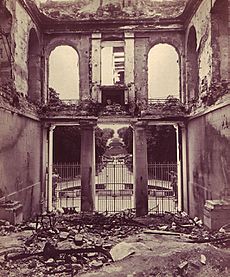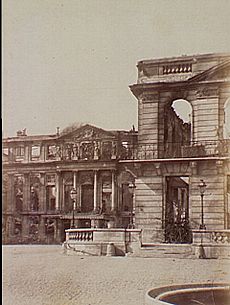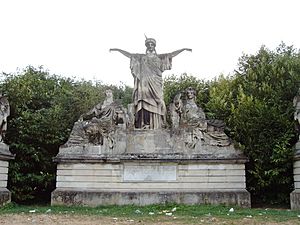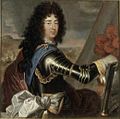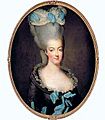Château de Saint-Cloud facts for kids
Quick facts for kids Château de Saint-Cloud |
|
|---|---|

The château and gardens, c. 1720
|
|
| General information | |
| Type | Château |
| Architectural style | French Baroque, Neo-Classical |
| Construction started | c.1570 |
| Completed | c.1701 |
| Demolished | 1891 |
| Client | Philippe of France; Marie Antoinette |
| Design and construction | |
| Architect | Antoine Le Pautre; Jean Girard; Jules Hardouin Mansart; Richard Mique |
The Château de Saint-Cloud (pronounced shah-TOH duh san kloo) was a grand château (a large French country house or castle) in France. It was built on a hill overlooking the Seine River in a town called Saint-Cloud, about 5 kilometers (3 miles) west of Paris. Today, the beautiful Parc de Saint-Cloud stands where the palace once was.
This amazing château was made bigger by important people like Philippe of France, Duke of Orléans in the 1600s. Later, Marie Antoinette also added to it in the 1780s. It was even home to emperors Napoleon I and Napoleon III. Sadly, the château was destroyed in 1870 during a war.
Contents
History of the Château
Early Beginnings: The Hôtel d'Aulnay
The story of the Château de Saint-Cloud began with a house called the Hôtel d'Aulnay. In the 1500s, a rich banking family from Florence, Italy, called the Gondi family, bought this house. They started turning it into a château.
The Gondi family had come to France with Catherine de' Medici, who was the Queen. In the 1570s, the Queen gave Jérôme de Gondi the house in Saint-Cloud. This house became the main part of the future château.
The château had a main front facing south. It also had a wing that ended in a special room called a pavilion. This pavilion offered a wonderful view of the Seine River. In 1589, King Henry III of France stayed here while fighting a war. He was sadly killed in the house by a monk.
The 1600s: A Royal Home
After Jérôme de Gondi passed away in 1604, his son sold the château. It was later bought back by Jean-François de Gondi, who was the archbishop of Paris. He made the château even more beautiful, especially its gardens. These gardens were designed by a famous gardener named Thomas Francine.
In 1654, the château was sold again to a banker named Barthélemy Hervart. He made the park much larger, covering 12 hectares (about 30 acres). He also built a large waterfall in the park.
Drawings from this time show that the château was built in an Italian style. It had a flat roof and walls decorated with paintings. Its gardens went down in terraces towards the Seine River, with fountains on each level.
In 1658, Hervart held a huge party at Saint-Cloud for the young King Louis XIV and his brother, "Monsieur". Soon after, Monsieur bought the château and its land.
Monsieur, the King's brother, spent many years making Saint-Cloud even grander. He hired an architect named Antoine Le Pautre. Le Pautre added new wings to the château in 1677. The château became shaped like a "U" facing the Seine River.
Inside, the rooms were beautifully decorated. One long room, the Galerie d'Apollon, was decorated with paintings about the Greek god Apollo. Monsieur's last child, Anne Marie d'Orléans, was born here in 1669. She later became the grandmother of King Louis XV of France.
In 1670, Monsieur's wife, Princess Henrietta of England, died at the château. In 1677, Monsieur held a magnificent party for King Louis XIV. The King was so impressed by the grand gallery at Saint-Cloud that he decided to build an even bigger one at his own palace, Versailles.
After Le Pautre died, other architects like Jules Hardouin Mansart continued the work. Mansart designed a grand staircase. André Le Nôtre, a famous landscape designer, redesigned the gardens. The park still looks much like it did then.
The 1700s: A Queen's Retreat
Saint-Cloud stayed with Monsieur's family, the Dukes of Orléans, for most of the 1700s.
In 1785, King Louis XVI bought the château for his wife, Marie Antoinette. She believed the air there would be good for her children. She paid a lot of money for it.
Marie Antoinette wanted to make Saint-Cloud her own special home. She hired her favorite architect, Richard Mique, to make changes in 1787-1788. He made the main building bigger and rebuilt the side facing the garden. New stone stairs were added to reach the royal apartments.
The château was filled with beautiful furniture from other royal homes. New, fancy furniture in the latest style was also made for Saint-Cloud. These deliveries continued right up to the start of the French Revolution.
In 1790, a famous meeting between Marie Antoinette and a politician named Mirabeau happened at Saint-Cloud. After the Revolution, the château's contents were sold off.
The orangery (a special building for orange trees) at Saint-Cloud was where a big event happened in 1799. This was the coup d'état (a sudden takeover of power) of 18 Brumaire. It led to Napoléon Bonaparte becoming the leader of France. He was later declared Emperor of the French at Saint-Cloud in 1804. The château became a main home for Napoleon and his family.
The 1800s: Imperial Grandeur and Destruction
Napoleon I loved Saint-Cloud and made it his favorite home. He turned one of the rooms into a throne room. However, he and the rulers who came after him mostly focused on decorating the inside.
In 1852, Napoléon III was also declared Emperor of the French at Saint-Cloud. During his reign, he and Empress Eugénie often stayed at the château in spring and autumn. Napoleon III had the orangery taken down in 1862. Empress Eugénie redecorated one of the bedrooms in the old royal style.
The château was often used to host royal families from other European countries. For example, Queen Victoria and Prince Albert of England stayed there when they visited Paris in 1855.
Sadly, Saint-Cloud was where Napoléon III declared war on Prussia on July 28, 1870. During the siege of Paris, Prussian soldiers occupied the park and fired cannons at Paris from there. French cannons fired back, hitting the château. It caught fire and burned down on October 13, 1870. Luckily, Empress Eugénie had already moved many of its valuable contents to safety.
The remaining walls, which had no roof, were finally torn down in 1891. One part of the château's front was saved. It was bought by Ferdinand I of Bulgaria and added to his palace in Bulgaria.
Today, only a few smaller buildings and the huge park remain. This area is now called the Domaine national de Saint-Cloud. It includes gardens designed by Le Nôtre, Marie Antoinette's flower garden, and other beautiful areas. There are ten fountains and a viewpoint of Paris called "la lanterne." A lantern was lit there when Napoleon I was staying at the château.
The Pavillon de Breteuil in the park has been the home of the General Conference on Weights and Measures since 1875. This is where decisions about how we measure things like meters and kilograms are made.
The 1900s and 2000s
A large sculpture group called France crowning Art and Industry was placed in the lower part of the park in 1900.
In 1999, a big storm damaged many thousands of trees in the park. But work continues to restore and care for the park.
Since 2003, the park has been the location for the Rock en Seine music festival.
Should the Château be Rebuilt?
Since 2006, there has been a group that wants to rebuild the Château de Saint-Cloud. This group, called "Reconstruisons Saint-Cloud!" (Reconstruct Saint-Cloud!), hopes to raise money from private donations and visitor fees.
Images for kids
See also
 In Spanish: Palacio de Saint-Cloud para niños
In Spanish: Palacio de Saint-Cloud para niños
- Railway of the Prince Imperial
- List of Baroque residences



